Return to Index |
Previous Image |
Next Image |
These small tadpole features, referred
to as cometary knots, are a part of the structure known as the Helix Nebula,
or NGC 7293, which is about 450 light years from Earth in the constellation
Aquarius. Helix spans about 1.5 light years and is an example of a planetary
nebula, essentially a shell of gas that some types of stars eject at the
end of their lives. The cometary knots are balls of gas that, while they
appear small from Earth, are actually quite large. The heads alone are
at least twice the size of our solar system; the tails stretch another
100 billion miles. Astronomers think the knots formed as the product of
a collision between gases of different temperatures. The basic model suggests
that there are small knots of cool gas being excited by radiation from
the central star, which is located beyond the upper right area of this
image. Over time, the knots will most likely dissipate into the dark,
cool interstellar space surrounding them.
(Courtesy of NASA's Hubble Space Telescope)
References:
http://www.seds.org/billa/twn/types.html#planetary
http://antwrp.gsfc.nasa.gov/apod/ap000828.html
http://antwrp.gsfc.nasa.gov/apod/ap970720.html
Object |
Distance from Earth |
Wavelength |
Cometary Knots |
700
light years |
Optical |

